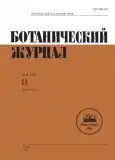SPECIES OF PUCCINELLIA (POACEAE) IN PLANT COMMUNITIES IN THE SOUTH OF WESTERN SIBERIA
- Authors: Chupina I.S.1, Korolyuk A.Y.1
-
Affiliations:
- Central Siberian Botanical Garden of SB RAS
- Issue: Vol 108, No 11 (2023)
- Pages: 971-979
- Section: COMMUNICATIONS
- URL: https://rjsvd.com/0006-8136/article/view/666421
- DOI: https://doi.org/10.31857/S0006813623110030
- EDN: https://elibrary.ru/ZHAIUA
- ID: 666421
Cite item
Abstract
The study is based on analysis of 1415 relevés representing communities with presence or dominance of Puccinellia tenuissima, P. gigantea, and P. kulundensis from the southern part of Western Siberia. The ecological plasticity of these species has been shown. Their phytocenotic optimum is revealed using the species indicator values in relation to soil moisture and richness-salinity gradients. The communities dominated by P. tenuissima are most common in the south of Western Siberia. This is the reason of the highest ecological plasticity of this species. In contrast, P. kulundensis is the most environmentally stable and shows the greatest dominant potential. Among the studied species P. gigantea rarely achieves high cover. The West-Siberian communities dominated by endemic P. kulundensis are described as a new association Puccinellietum kulundensis ass. nov. from the class Festuco-Puccinellietea Soó ex Vicherek 1973, the order Scorzonero-Juncetalia gerardii Vicherek 1973 and the alliance Cirsion esculenti Golub 1994.
About the authors
I. S. Chupina
Central Siberian Botanical Garden of SB RAS
Author for correspondence.
Email: irachupina@mail.ru
Russia, 630090, Novosibirsk, Zolotodolinskaya Str., 101
A. Yu. Korolyuk
Central Siberian Botanical Garden of SB RAS
Author for correspondence.
Email: akorolyuk@rambler.ru
Russia, 630090, Novosibirsk, Zolotodolinskaya Str., 101
References
- Czerepanov S.K. 1995. Vascular Plants of Russia and Neighboring States (within the Former USSR). Saint Petersburg. 992 p. (In Russ.).
- Hammer Ø., Harper D.A.T., Ryan P.D. 2001. PAST: Paleontological Statistics Software Package for Education and Data Analysis. – Palaeontologia Electronica. 4 (1): 1–9.
- Korolyuk A.Yu., Lysenko T.M., Golovanov Ya.M., Sinelnikova N.V., Polyakova M.A., Chupina I.S., Yamalov S.M. 2022. Syntaxonomical notes. 1. – Flora and Vegetation of Asian Russia. 15 (2): 152–165 (In Russ.).
- Korolyuk A.Yu., Kipriyanova L.M. 1998. Prodromus es-testvennoy rastitel’nosti yugo-vostoka Zapadnoy Sibiri (Altayskiy kray i Novosibirskaya oblast') [The prodromus of natural vegetation of the south-eastern part of western Siberia (Altai Territory and Novosibirsk Region)]. – Botanicheskie Issledovaniya Sibiri i Kazakhstana. 4: 63–89 (In Russ.).
- Korolyuk A.Yu. 1993. Sintaksonomiya rastitel’nosti yuga Zapadnoy Sibiri. Gigrofil’naya i galofil’naya rastitel’nost' [Vegetation syntaxonomy of southern part of Western Siberia. Hygrophilous and halophilous vegetation]. Novosibirsk. 33 p. Deposited in VINITI 11.06.93. No. 1643–В93 (In Russ.).
- Korolyuk А.Yu. 2006. Ekologicheskiye optimumy rasteniy yuga Sibiri [Ecological optima of plants in the south of Siberia]. – Botanicheskie Issledovaniya Sibiri i Kazakhstana. 12: 3–28 (In Russ.).
- Kuminova A.V., Vagina T.A., Lapshina E.I. 1963. Geobotanicheskoye rayonirovaniye yugo-vostoka Zapadno-Sibirskoy nizmennosti [Geobotanical zoning of the southeast of the West Siberian lowland]. – In: Rastitel’nost’ steponoy i lesostepnoy zon Zapadnoy Sibiri. Trudy Tsentralnogo sibirskogo botanicheskogo sada. Vyp. 6. Novosibirsk. P. 35–62 (In Russ.).
- Malyshev L.I. 1973. Floristic zoning based on quantitative characteristics. – Bot. Zhurn. 58 (11): 1581–1588 (In Russ.).
- Mirkin B.M., Gogoleva P.A., Kononov K.E. 1985. The Vegetation of Central Yacutian Alases. – Folia Geobotanica et Phytotaxonomica. 20: 345–396.
- Nikolskaya N.I. 1985. Distribution pattern of solonchak vegetation in steppe and desert areas of the USSR. – Bot. Zhurn. 70 (3): 332–340 (In Russ.).
- Theurillat J.-P., Willner W., Fernández-González F., Bültmann H., Čarni A., Gigante D., Mucina L., Weber H. 2021. International Code of Phytosociological Nomenclature. 4th edition. – Appl. Veg. Sci. 24 (1): e12491.
- Vagina T.A. 1963. Zasolennye luga Baraby i Kulundy [Saline meadows of Baraba and Kulunda]. – In: Rastitel’nost’ steponoy i lesostepnoy zon Zapadnoy Sibiri. Trudy Tsentralnogo sibirskogo botanicheskogo sada. Vyp. 6. Novosibirsk. P. 163–182 (In Russ.).
- Zverev A.A. 2007. Informatsionnye tekhnologii v issledovaniyakh rastitel’nogo pokrova [Information technology in vegetation research]. Tomsk. 30+4 p. (In Russ.).
Supplementary files













